I just got back from a weeklong trip to Southern California, mostly working with a little playtime in Disneyland thrown in. The weeds and slugs took advantage of my absence to invade my helpless garden. I've been coping with the carnage all weekend, but I'm taking a break to share some pictures from my trip. I grew up in Northern California, so I took the local flora for granted. Now that I've been gone awhile (20 years as of next month), and I'm a gardener, I notice things when I go back that were just part of the background when I was growing up. Such as...
Oleander
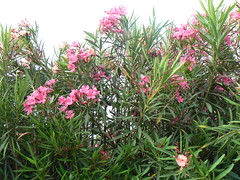

Oleander is everywhere, both in SoCal and where I grew up. It's often found growing alongside the freeway, or in the case of the ones in these pics, growing alongside a gas station parking lot in LA. They're kind of like rhodies are in the maritime Northwest - all-purpose, low-maintenance shrub found in just about every garden, overused to the point of being boring. Every now and then, I find them advertised for sale in catalogs of tropical plants, listed alongside orchids and other exotics (and with prices to match). I just laugh and wonder what the buyers would think if they could see their precious tropical shrub next to a California freeway.
Then there's this beauty--the Bird of Paradise:
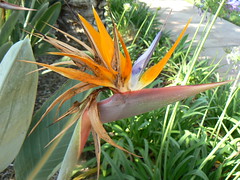
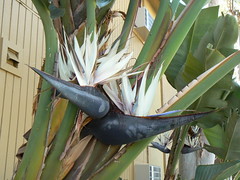
My grandmother had one of these in front of her house in Oakland when I was a kid. Up here, like oleander, they're sold as pricey tropicals. Until this trip, I never noticed that there was more than one variety. The colorful one is the one I remember seeing all the time. The other one isn't as pretty IMHO, but it's way larger. The blooms are about twice the size of the colorful ones.
The pictures above were all taken just outside Disneyland. This one was taken inside the park, in Fantasyland to be precise. Just look at these delphiniums!

They belong in Fantasyland too. I think I'd have better luck spotting Tinkerbell in my garden than growing delphiniums that look that good. Apparently Fantasyland is not only where dreams come true; it's also where slugs don't exist.
In addition to Disneyland, we paid a visit to San Gabriel Mission, or as it's officially known,
Mission San Gabriel Archangel. There's some very nice landscaping outside the mission, including this striking cactus, which really pops against the adobe wall of the mission and alongside the rounded shrubs:

The mission includes a peace garden in the courtyard, with a lovely collection of succulents and other desert plants. Here's a sampling:
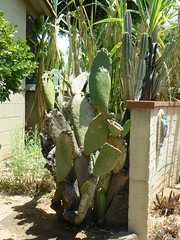
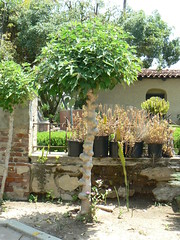


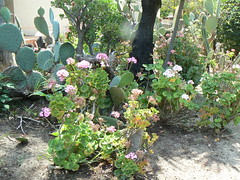
Yes, those are geraniums (or pelargoniums for you horticultural purists) in that last pic. They become shrubs when left to their own devices in places with mild winters.
So there ya go--a glimpse or two of flora from the Granola State. I hope you enjoyed this bit of armchair travel with your Rainy Day Gardening correspondent. Now, back to your regularly-scheduled maritime climate...














